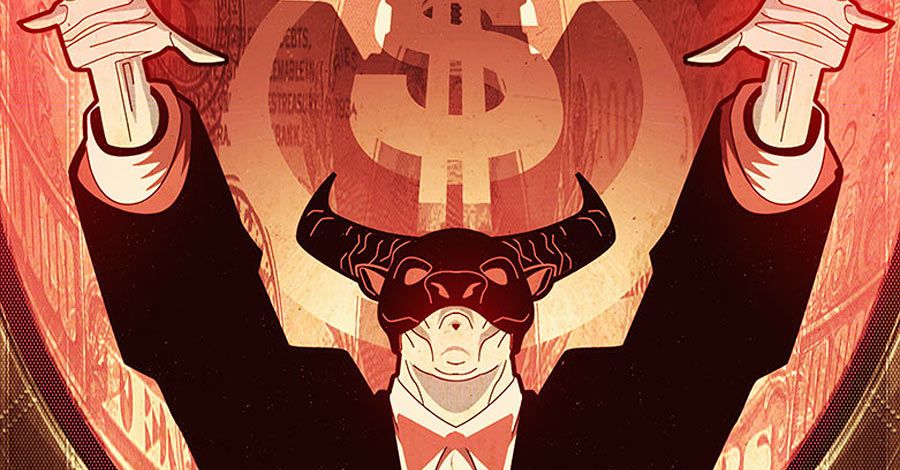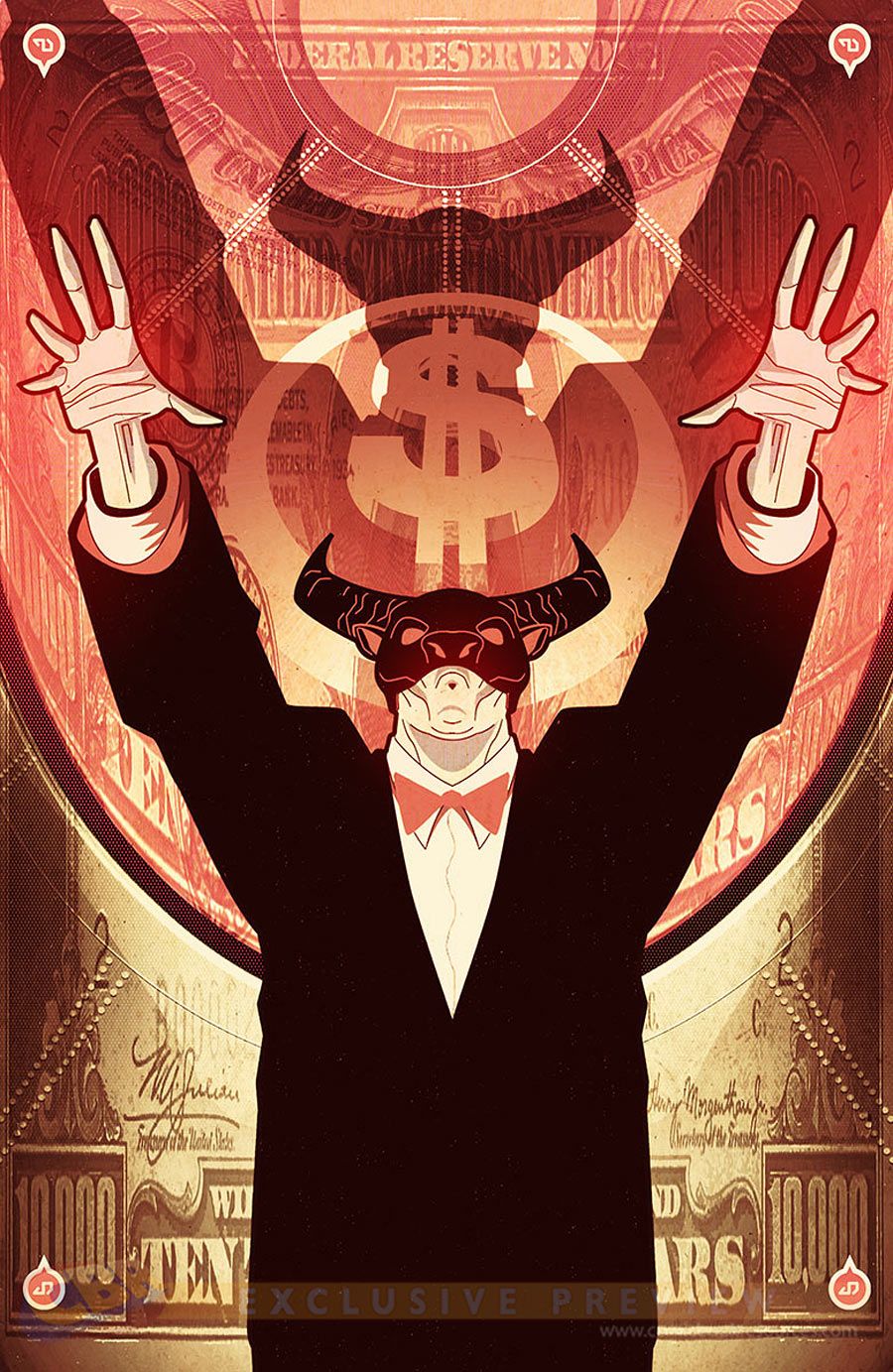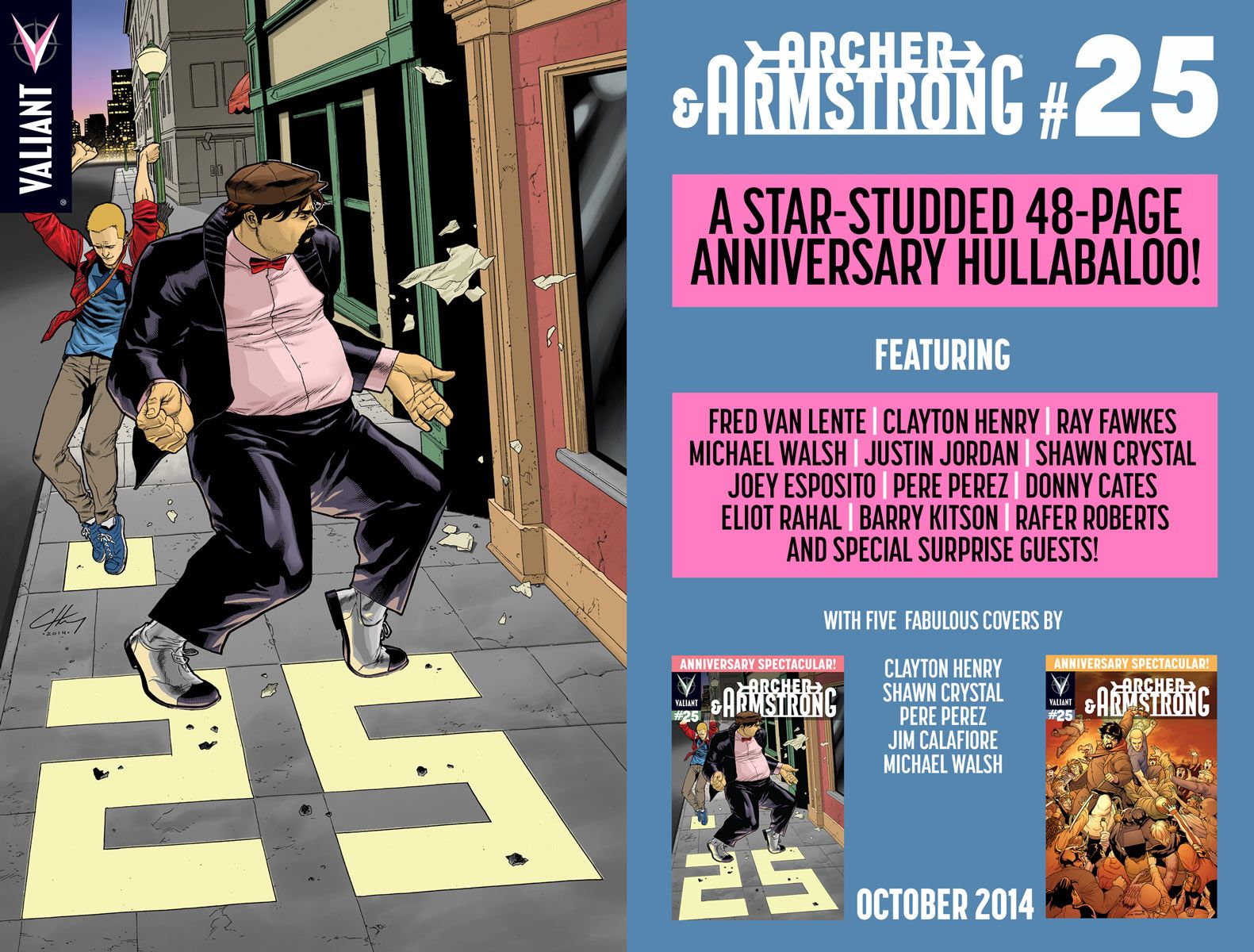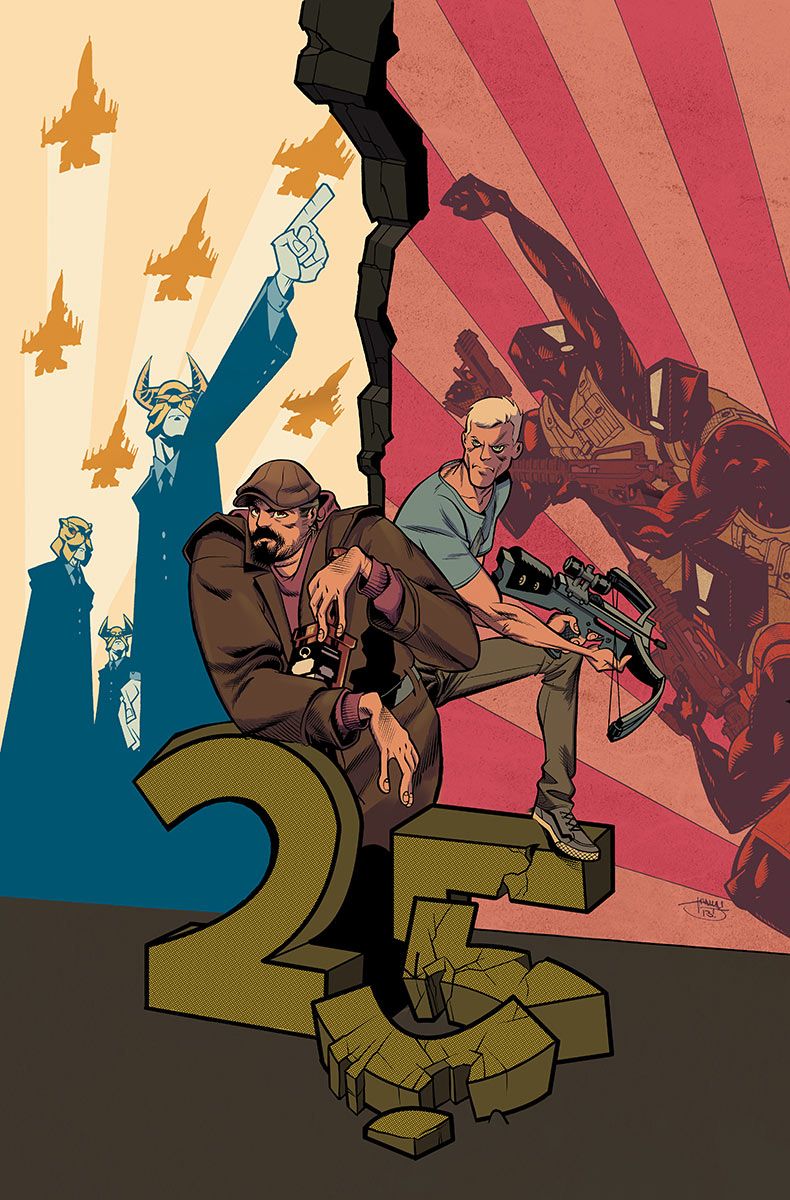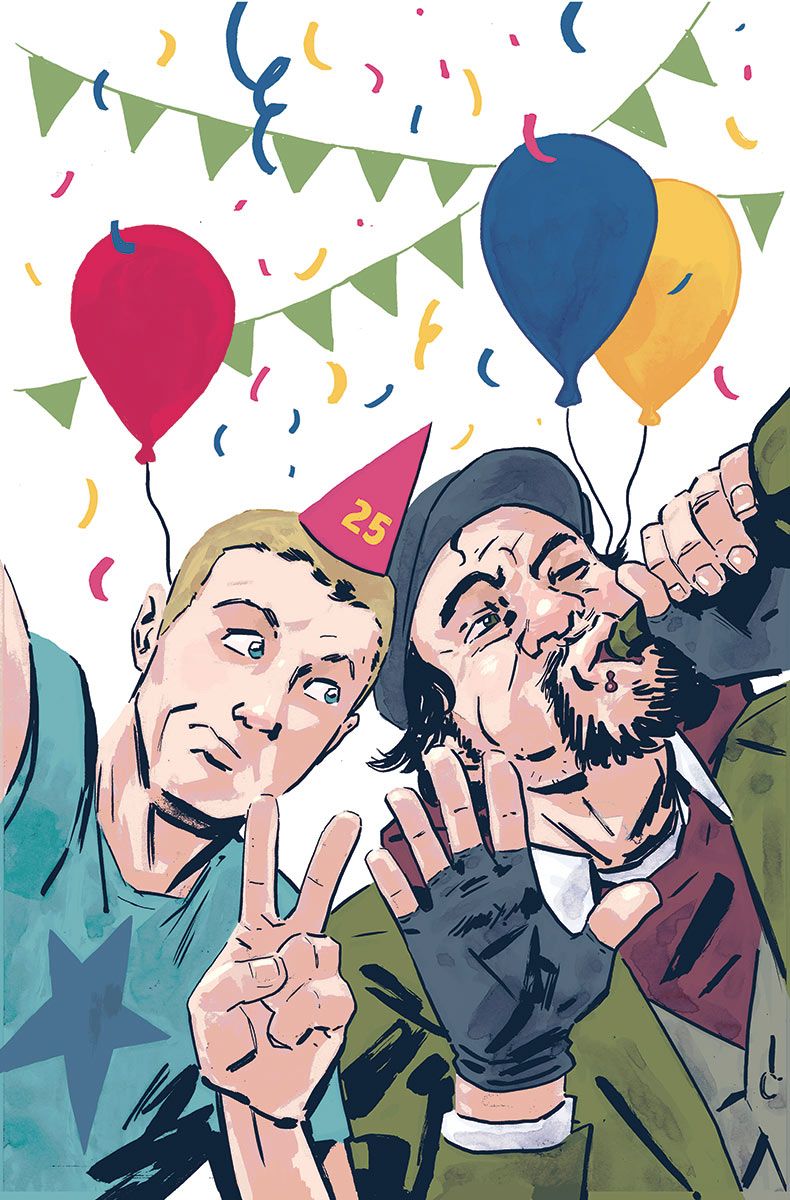This November, Ray Fawkes heads to the Valiant Universe to give the villains a little bit of the spotlight in "Archer & Armstrong: The One Percent," a one-shot focusing on the first Sect of villains that Archer and Armstrong ever faced down. With art by Joe Eisma, the issue centers on the gold bull and bear-masked villains following their major defeat at the hands of Archer and Armstrong during the "Sect Civil War" -- and one of their younger members feels it might be time for a transition. The one-shot spins out of Fawkes' short story in the upcoming "Archer & Armstrong" #25 anniversary issue.
A story about the devil-worshipping Sect of Wall Street brokers and bankers couldn't come at a more opportune time for Valiant, considering the One Percent are rumored to be a part of the upcoming "Archer & Armstrong" film. The one-shot will not only reintroduce the villains to the Valiant Universe, but help readers understand the inner workings of its richest and most devious sect.
CBR News spoke with Ray Fawkes about his upcoming issue, how it deals with the aftermath of "Sect Civil War," the challenges in writing a completely unsympathetic character, the challenges of bringing villains into the spotlight at Valiant and more.
CBR News: Ray, tell us a bit about "Archer & Armstrong: The One Percent," and how it reintroduces the One Percent to the Valiant Universe.
Ray Fawkes: Well, as readers of "Archer & Armstrong" are aware, the One Percent are a conspiracy that happens to be true in that universe, about a bunch of Wall Street investors and bankers and types who have cut actual deals with the devil -- or at least they say so. They do black magic and that's got a lot to do with why they're secretly ruling part of the world -- or at least, it's got something to do with why they're so super rich! They're very, very, very bad people, and this is our chance to show how they work behind the golden masks of bulls and bears.
"Archer & Armstrong" #25 marks your first entry in the Valiant Universe with a short story that leads into this issue. What drew you to Valiant as a publisher, and "Archer & Armstrong" in particular?
I've got to say, it's clear from their books that the environment at Valiant is super creative, super fun. It's all about these great books with these characters that are just exploding in all these amazing, sometimes hilarious, sometimes exciting but interesting directions. There's nothing static about the feeling of any of the stories. There's a lot of excitement; it's easy to get caught up in it. When I talked to these guys about maybe doing something, I found myself getting just as excited, because what you can see in the books is what's happening in the offices. They create a work, they want people to go wild and I'm really happy to be part of it.
The last time we saw the One Percent was back during "Archer & Armstrong's" "Sect Civil War." What have they been up to since then? Where does this story pick up in the timeline?
I mean, they got their asses pretty soundly kicked in the Sect Civil War, to put it bluntly. This picks up where there's this attitude in the One Percent where, "Is this business as usual or should we be changing our ways?" We're pretty much focusing on one of the characters who believes he has a vision for how the One Percent should continue. He's a really terrible person, and his ideas of what should happen form the focus of this particular story. I think it's entertaining stuff.
There haven't been many Valiant books focusing solely on villains. What was your challenge in writing a book like this?
Well, it's the same challenge that you face with any villain-focused story. You're dealing with a really terrible character, but you have to understand how and why the character operates. They can't be one-dimensional, and they can't be about doing bad things for bad things' sake. The real challenge is to give readers an idea of how this guy lives and breathes and how the One Percent lives and breathes and how someone wants to be part of this group -- what background you would have to have, what mental quirks you would have to have to sympathize with them, but sympathizing with them could be possible.
Was there any temptation to try and make the One Percent, as an organization, sympathetic villains at all? What about the main character -- was there a temptation to make him more of a sympathetic figure in the story?
No. [Laughs] It was more like there was a motivation to make him somebody that the readers might perhaps love to hate, or that they would find entertaining. But the guy is -- I think there's a time for sympathetic villains or villains that have been dealt a raw deal, but when you're dealing with mega-rich people, who make conscious decisions to perform black magic so they can cement their control over the world -- I think you have to bend pretty far to find sympathy to those guys, unless they're forced into their situation. This character has not been forced into what he's doing. It's more a matter of, "Can I make this guy fun enough that readers would want to see what he's up to and want to see what the One Percent is doing around him?"
You've had the chance to focus on antiheroes like John Constantine and the members of Justice League Dark, but what was the experience like writing a character that was just so unrepentant for their actions -- completely unsympathetic?
It was fun in this case, partly because it was a vicarious thrill, but partly because while the One Percent might be a conspiracy theory in this book, and we're throwing black magic into the mix -- it's obviously very fictional -- the themes that we're dealing with are actually extremely important. They might be some of the most important themes of living in the world today: income inequality and indifference to suffering. The fun for me in approaching this story, and hopefully, the fun for readers, is we get to actually talk about some of this stuff. The fun to be had through this guy is almost like a broad satire, but we are addressing some of the actual ills of the world. It's nice to talk about some of that stuff.
Joe Eisma is providing art for the series. What is it about Joe's style that you think will make him a good fit for this one-shot?
Oh, man. I think the ability he has to ground things in the very real, while at the same time [depicting] something completely unreal in the environment -- he has this ability to do these dreamlike images where you see something so crazy, and things are so real again, that you turn the page back and ask, "Did that really happen?" For me personally, in this particular story, I think he's a perfect fit.
Being an artist in your own right, as a comics writer, how has that artistic background helped you in crafting your scripts for different artists?
It certainly helps me visualize stories to a certain degree, but usually when I'm writing for another artist, all I have to do is cast myself into the artist's shoes for a minute to make sure that what I'm doing is providing them with something they can run with, rather than walking them down -- which is tempting to do when you're writing a script. I want to make sure I'm giving them enough that the artist can really breathe and express themselves in their own way. I definitely have that in mine, because I have the experience of having drawn some books -- most especially the books I've written for myself -- where I look at the script and go, "Oh, man -- I should have let myself be more free!" [Laughs] I can sympathize, and I think that helps.
What else is in store for you coming down the line?
I'm doing a couple of other little things with Valiant, and I'm continuing writing the books for DC. I'm just going to say that any fans of my work should pay really close attention during San Diego Comic-Con.
I had a blast doing this and I hope fans enjoy this look at the Valiant Universe through their villains, because I think it'd be really cool if there were more villain books.
"Archer & Armstrong: The One Percent" arrives in stores this November.

